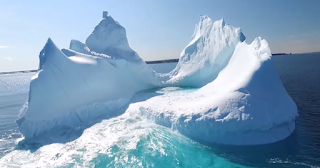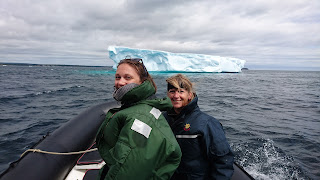Whale Watching FAQ
Whale Watching FAQ
Planning your trip to the island man!! (When global warming truly kicks in I think we will be the next Jamaica!)
Looking to see the lumbering behemoths, the gentle giants of the sea, those amazing cetaceans that inspire us, amaze us and instill that wonderful sense of natural awe? Well Newfoundland is the place to do it with the largest annually returning numbers of cetaceans (whales) in the world to feed right here!
As I say to be well informed is to be well armed, so here is the information you need to have a spectacular whale tour any time of the season according to our expert, Skipper Bob Bartlett!
When is the best time to see whales in Newfoundland?
Whales migrate north from areas of the South North Atlantic (Oxymoron I know) like the Dominican Republic. They start to arrive in April and continue arriving through the season. Whales do not necessarily stop to feed in one place all summer but move around so like our friend Finnegan the Humpback he arrives early and usually moves out midseason to other areas.Whale numbers peak with the arrival of the Capelin. Capelin are a small smelt like fish that arrive here by the billions to spawn in the shallows of the Newfoundland coast This is what attracts the whales to come to Newfoundland, the Capelin buffet that is available to our guests from the latter part of June to approximately the latter part of August. The whales that arrive early have been seen feeding on Krill, small herring and even plankton if it is thick enough.
Outside of peak season there are other species of whales to see like the Minke whale. We also have porpoises, dolphins and even Orcas can arrive the latter part of the season.
 |
| Who is watching whom? |
In the earlier part of the season you can enjoy more behemoths ICEBERGS!!!! on your trip. This year is shaping up to be a spectacular iceberg season.See our latest videos of icebergs on our Facebook Page taken recently:
Stay in touch with what we are seeing by liking our Facebook page so you can view our most recent sightings. That way you know what to expect closer to your arrival. Sign up! We are not trying to sell you anything; we just like to share our posts with like minded cetacean loving individuals!
You can read more about our Icebergs sightings here
What type of whales can I expect to see?
During the peak season our most popular whales are Minke Whales, Sperm Whales, Fin or Finback Whales and the majestic Humpback Whale the Showman of the Ocean as I call them.
Humpback Whale
Our favourite and most popular whale is the majestic Humpback. Finnegan above is a Humpback whale.The tail fluke print of a Humpback Whale as pictured above is as unique to that whale as a fingerprint is to a human being. You can even be a citizen scientist and submit your fluke shots for identification to organizations who identify individual's migration routes and feeding areas. We strongly encourage it.
Humpbacks range in the 45-50 foot range. They eat up to 2 tons of Capelin per day during the feeding season. More amazing Humpback facts are revealed on our tour as well as displays of breaching, tail lobbing and other amazing whale feats!
Minke Whales
Minke Whales are the smallest of the whale family in the 22 - 25 foot range similar in body shape to the Blue and Fin Whales but much smaller. . Minke whales are black or dark blue on their upper side with a light white colour on their belly and under their flippers. Just like Humpback whales, they feed on small fish such as herring or capelin. Blue whales and even Narwhales have been spotted in Trinity Bay though it is not a common occurrenceSperm Whales
The Sperm Whale (same type as Moby Dick) is the only variety of toothed whale that feeds in Newfoundland. (Killer Whales or Orcas are actually toothed but technically not whales but Dolphins).
In the 45-55 foot range Sperm Whales dive deep for long periods of time to feed on the deeper dwelling creatures like Giant Squid and other denizens of the deep. You can tell the Sperm Whale at a distance by the spout from its head coming off at about a 30 degree angle. It is very distinct.
Fin or Finback Whales
Fin or Finback whales ( named for the appearance of their fin so far back on their bodies) are the second largest of the whale family next to the largest whale species the Blue Whale. The Fin Whales can reach up to 80 feet in length though the average in the northern hemisphere tends to be in the 62-66 foot range and in the southern hemisphere 66 - 72 foot range.
The Fin Whale's spout is high and straight and distinguishable from quite some distance as opposed to the Humpback whose spout is closer to the water and mushrooms as it completes its breath. I can usually tell the type of whale long before we reach them. Here is a video of the Fin Whale taken by us last season passing the boat.
Dolphins
We get three variety of Dolphins in Newfoundland, the Atlantic White Sided Dolphin, Common Dolphin and the White Beaked. They are very strong swimmers often frollicking in the wake or the bow wave created by our boats.Dolphins can get up to ten feet in length with large curved dorsal fins which distinguishes them from other species. They are mostly dark grey with a light white on their sides. They can weigh up to 775 pounds often travelling in large groups of 10-20 dolphins but can get as large as 100 individuals.Will we only see whales? Is there other wildlife we can see?
As Forest Gump said " Life is a like a box of chocolates, you never know what you are going to get." Much like the variety of species you can see on our tours. From the middle of June until the latter part of August you are almost certainly guaranteed to see Humpbacks, Fin Whales and a variety of seabirds including Puffins, Eagles, Guillemots, Razorbills, Northern Gannets and many more. It amazes me what we see and have seen from Ocean Sunfish to Leatherback Turtles. |
| Leatherback Turtle from our Tour 2017 |
How often do you see whales on tours? Is there a better time of day to see them?
One time of day seems no better than another for spotting whales, The cycle for whales here is all about feeding so whales gorge themselves to build up their fat reserves of which they may lose up to 50% from one season to the next.IN season we see whales almost every trip. Our percentages for the last two years have been better than 98 %.
Why should I book with Trinity Eco Tours?
If you want the most action packed, fun filled, most informative and most relaxing tour you should book with us. We provide you with an immersion suit for warmth during the colder part of the season, (something you do not get on the big tour boats so dress warm before you go!).Our photos and videos have been featured world wide for their amazing content which have all been take on our tour. See videos from us on Youtube and Facebook
Trinity Bay Newfoundland is a very popular tourist destination and if not on your list you should add it. We have been welcoming visitors for over 400 years!!! Trinity has many local museums, historic sites, theater, fine dining, hiking trails, popular local micro brewery amongst many other attractions. If you miss us you missed out! Plus the variety of wildlife in season is unparalleled as well as the spectacular seascapes and seacaves. Experience wildlife, icebergs and culture with the locals and you might not want to go back
.
What type of boats will be used on my whale watching tour?
On our Whale Watching Tours we use Rigid Hull Inflatable Boats (RHIB). Our Rigid Hull Inflatable Boats are the same type of boats used for rescue craft in the offshore industries. They are the most stable, comfortable vessel for work vessels and our tours. Our boats and our skippers are Transport Canada certified so we are well equipped to handle your comfort and your care.An additional selling feature of our tours is that you are less susceptible to seasickness as the vessel does not slow roll out like a large boat. Being seasick during your tour is not conducive to a good trip. We ususally have Gravol available prior to our tours if you think you may need it. Very few people have ever been seasick aboard our tours.What Should I Wear on A Whale Watching Tour?
As mentioned we provide you with a one piece full immersion suit that is a nylon covered Neoprene suit. This protects against the wet and the cold in the shoulder seasons. It has been commented by many a passenger that it saved the trip for our patrons for their warmth and comfort.As I so often like to say it is better to have and not need as opposed to need and not have so good footwear is a must, adequate thermal socks in season and of course gloves and mitts. Even during the peak of the summer temperatures can drop by 10 Degrees Celsius when we get out into the middle of the bay!
How do I book?
You can book online through either of the links on our Facebook Page
or our website TrinityEcoTours.com
or call us direct at (709) 464-3712 or our accommodations in Trinity (709) 436-3011. Skipper Bob would be glad to help.
So come and have the best whale watching experience this summer, you will be glad you did!!













Comments
Post a Comment